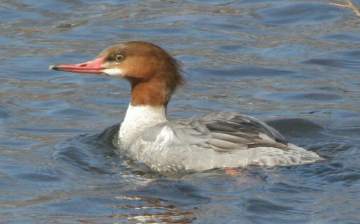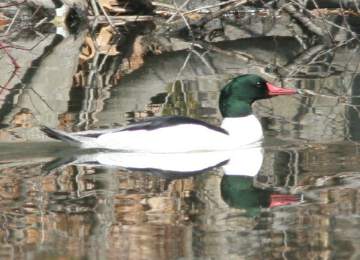

PHOTO COURTESY OF GARRY KESSLER
A female common merganser
December 10, 2010, Page 4-5
NATURE NOTES
By Annie Reid
Westborough Community Land Trust
Mergansers: December’s ducks
As frigid weather sweeps toward us in December, common mergansers are the last ducks to stop over on Westborough’s ponds and lakes, just before the waters ice over. They’re one of several kinds of ducks that pass through on their way south, already bright in breeding plumage.
The first flock of 50-60 common mergansers has already been sighted on Lake Chauncy. You might also spot them in smaller groups of half a dozen or so.
Like most ducks we see, male and female common mergansers (Mergus merganser) look different. As usual, the males are the flashy ones. They have a green head, red bill and feet, black back, and contrasting white sides and breast. The females are less showy, all the better to avoid notice while they sit on a nest or tend young. The females are light gray, with a reddish brown head, white chin patch, and red-orange bill and feet.
These ducks are relatively long, about 25 inches long – a couple of inches more than the mallards we’re used to seeing everywhere. Common mergansers ride low in the water. They fly fast and straight, often using their feet to give themselves a running start on the water when they take to the air.
They spend most of their time on the water and even sleep there at night. They’re more comfortable on water than on land because their feet are positioned far back on their body, near the tail, making it awkward to balance when they stand. Instead, their large feet are well placed for diving and swimming under water.
If you spot some common mergansers, have some fun watching them dive. It can be a bit of a guessing game, as they give a slight leap and disappear under the water, only to reappear somewhere else. Dives typically last about 30 seconds and go 6-12 feet deep, but these ducks can stay under for 2 minutes and dive 19 feet down.
If a diving merganser is lucky, it will come up with a fish and work to swallow it quickly, before one of its fellows can steal the prize away. Then the hunt continues, with the mergansers sometimes swimming with neck outstretched and head underwater, as they look below for fish.
Fish are slippery prey, but common mergansers are well equipped. Their bills have serrated edges that work well in gripping fish. These bills have earned them the nickname “sawbill.” To help them digest fish, bones and all, common mergansers have gizzards containing about a teaspoonful of gravel.

PHOTO COURTESY OF GARRY KESSLER
A male common merganser
They also eat other prey, including insects, frogs, mussels, and snails. They’ll dive to the bottom and poke around in the mud or gravel there, and pick prey off the bottom
For a good look at common mergansers, binoculars are helpful. These ducks – and others –tend to spend most of their time far out in the middle of our lakes, but they may feed closer to shore in shallower water.
Why are ducks so shy at this time of year? One reason is duck hunting season, which occurs in late fall and early winter. Common mergansers apparently aren’t especially good to eat so they are not prized by duck hunters, but they do get shot. In Westborough, hunting is not allowed (except by permission of the landowner), but the state permits hunting at the Division of Fish and Wildlife’s Westboro Management Area (though not on Sundays). Also, town residents are sometimes surprised to discover that hunting is allowed on Mill Pond, which is one of the state’s SuAsCo (SUdbury-ASsabet-COncord) flood control reservoirs. The state owns the shoreline, which is technically part of Quinsigamond State Park.
What other ducks might you see in December while there’s still open water in Westborough? You’ll see plenty of mallards. Look for other diving ducks, such as buffleheads (Bucephala albeola), which seem to like the Westborough Reservoir, ring-necked ducks (Aythya collaris), and hooded mergansers (Lophodytes cucullatus; see Nature Notes of March 31, 2006 at http://www.westboroughlandtrust.org/nn/nn49.php).
In the spring, common mergansers will pass through Westborough again, as soon as the ice melts. They’ll be heading toward their nesting areas in northern New England and across Canada. They nest in tree holes and rock crevices along wooded lakes and streams, but they’ll also sometimes nest on the ground. For this reason, they are not as limited in their nesting opportunities as are wood ducks (Aix sponsa; see Nature Notes of June 9, 2006 at http://www.westboroughlandtrust.org/nn/nn54.php), which nest only in tree holes and in the nest boxes that people put up for them on ponds.
Common mergansers typically have 9-12 ducklings, which are covered with down and have their eyes open when they hatch. After 1-2 days, they leave the nest and can swim and feed themselves. They sometimes ride on the mother’s back and even manage to stay there during a dive. After 8 days, they can do their own diving.
As fish eaters, common mergansers are the “top predators” in the food chain of who-eats-whom in lakes and streams. For this reason, they can serve as indicators of the health of North American waters. If acid rain changes the nature of the water and the fish that can live in it, common mergansers will be affected. Likewise, they will suffer if waters become contaminated with chemicals such as PCBs, DDT, and mercury, which build up in the tissues of prey and get passed “up” the food chain. They also need clear water for hunting by sight, so changes that cloud the water are not good for them.
You can find common mergansers right in Westborough at the right times of year, but you might also notice them if you travel in other parts of the world, including Ireland, Scotland, Scandinavia, and parts of China, Japan, and Korea. North American common mergansers are slightly smaller than those found elsewhere.
Busy as this time of year can be, find some time to look for the interesting ducks that December brings to town.
Date index
Month (December)
Common name index
Scientific name index
Category index